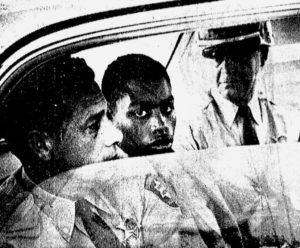
Henry Montgomery, flanked by two deputies, awaits the verdict in his trial for the murder of Deputy Sheriff Charles H. Hurt in Louisiana. Montgomery, a 71-year-old prisoner who was 17 when he killed a sheriff’s deputy, learned Wednesday, June 21, 2017, that he will get a chance at parole, 54 years after the killing and a year after winning his appeal before the U.S. Supreme Court. (John Boss/The Advocate via AP)
Among the U.S. Supreme Court’s many rulings on juveniles and crime, several big cases over the past dozen years have narrowed the instances in which those who commit offenses under age 18 can be subject to the harshest penalties. A look at these recent cases:
This decision banned the death penalty for those under the age of 18. Prior to the ruling, 16- and 17-year-olds were eligible for capital punishment in some states.
THE CASE:
Christopher Simmons was 17 when he and a friend broke into a woman’s home in Missouri, bound her with duct tape, then threw her off a bridge into a river. Upon conviction, he was sentenced to death. Simmons’ appeals cited his age and other factors.
THE RULING:
In a 5-4 vote, the Supreme Court in 2005 banned the execution of offenders who are younger than 18 when they commit crimes. “When a juvenile commits a heinous crime, the State can exact forfeiture of some of the most basic liberties, but the State cannot extinguish his life and his potential to attain a mature understanding of his own humanity,” wrote Justice Anthony Kennedy.
Citing scientific research, the court determined that adolescent development had to be taken into account, even in violent murders. It was likely, the court said, “that the brutality or cold-blooded nature of any particular crime would overpower mitigating arguments based on youth as a matter of course, even where the juvenile offender’s objective immaturity, vulnerability, and lack of true depravity should require a sentence less severe than death.”
The decision prohibited life-without-parole sentences for juveniles in cases that did not involve murder.
THE CASE:
Terrance Graham was 16 when he and three other teens tried to rob a barbecue restaurant in Jacksonville, Fla. One of Graham’s accomplices hit the manager over the head with a metal bar, requiring several stitches. No money was taken in the 2003 incident. Graham pleaded guilty to armed burglary with assault or battery, and in a letter to the trial court he wrote, “This is my first and last time getting in trouble.” Graham received probation and was ordered to spend a year of it in the county jail. He was released in June 2004.
That December, Graham, then 17, and two 20-year-olds were arrested for an armed home invasion and robbery. Graham was found to have violated his probation and sentenced to life imprisonment. Since Florida has no parole, Graham’s only option for release would have been executive clemency.
THE RULING:
In a 6-3 vote, the Supreme Court in 2010 ruled that sentencing a juvenile offender to life without parole for a crime that doesn’t involve murder is unconstitutional. “The state has denied him any chance to later demonstrate that he is fit to rejoin society based solely on a non-homicide crime that he committed while he was a child in the eyes of the law,” wrote Justice Kennedy.
In 2012, Graham was re-sentenced to 25 years in prison. Depending on his behavior, he could be eligible for release as early as 2026, according to his attorney, Bryan Gowdy.
MILLER v. ALABAMA and JACKSON v. HOBBS
The decision prohibited mandatory life-without-parole sentences for juvenile homicide offenders, allowing the sentence only in rare cases after consideration of a teen’s circumstances and potential for change.
THE CASES:
In 2003, Evan Miller, 14, was at home with a friend in Moulton, Ala., when a neighbor, Cole Cannon, came by to make a drug deal with Miller’s mother, according to court records. The teens followed Cannon to his trailer. After all three smoked marijuana and drank, Cannon passed out and Miller robbed him. Cannon awoke and grabbed Miller, whose friend struck the man with a baseball bat. Miller then repeatedly beat Cannon, first with his fists, then with the bat, placing a sheet over the man’s head and shouting: “I am God. I’ve come to take your life.” The two boys set Cannon’s trailer on fire, and Cannon died of smoke inhalation and his injuries.
Miller’s life-without-parole sentence was the latest chapter in a chaotic childhood. He had an alcoholic, drug-addicted mother and an abusive stepfather, had been in and out of foster care and had attempted suicide four times, according to court records.
In the other case, Kuntrell Jackson also was 14 when he and two other teens set out to rob a video store in Blytheville, Ark. One of Jackson’s companions pulled a sawed-off shotgun from his jacket and fatally shot store clerk Laurie Troup. The teens fled without any money. Jackson, who had a juvenile record of car theft and shoplifting, was tried as an adult for the 1999 crime, convicted of murder and aggravated robbery, and sentenced to life without parole.
THE RULING:
In a 5-4 vote, the Supreme Court in 2012 said mandatory life without parole for juvenile homicide offenders was unconstitutional, amounting to cruel and unusual punishment. “In neither case did the sentencing authority have any discretion to impose a different punishment,” Justice Elena Kagan wrote. “State law mandated that each juvenile die in prison even if a judge or jury would have thought that his youth and its attendant characteristics, along with the nature of his crime, made a lesser sentence … more appropriate. Such a scheme prevents those meting out punishment from considering a juvenile’s ‘lessened culpability’ and greater ‘capacity for change’ … and runs afoul of our cases’ requirement of individualized sentencing for defendants facing the most serious penalties.”
At a re-sentencing hearing in March, Miller’s lawyers cited his abusive upbringing and argued that at 14, his brain wasn’t fully developed. The state argued Miller should remain behind bars for the rest of his life. Under an Alabama law adopted last year, a judge can either re-sentence Miller to life without parole or he can become eligible for parole after serving 30 years. A decision is pending.
An Arkansas judge re-sentenced Jackson to 20 years in prison. Disciplinary violations made him ineligible to come before the state parole board until last year, and his first request for release was denied. Jackson again went before the board in February. He was granted parole and conditionally released.
The decision made clear that the ban on mandatory life without parole in juvenile homicide cases applied retroactively, giving more than 2,000 inmates a chance for reconsideration.
THE CASE:
Henry Montgomery went to prison for fatally shooting Charles Hurt, an East Baton Rouge sheriff’s deputy, in 1963. Hurt was looking for truants and came upon Montgomery, a 17-year-old skipping school. Montgomery, now 71, was at first sentenced to death, then retried and sentenced to life without parole.
Montgomery’s lawyers argued the 2012 high court decision should apply to inmates already serving such sentences; some states disputed its application to those locked up for long-ago crimes.
THE RULING:
In a 6-3 vote, the Supreme Court in January 2016 ruled for Montgomery, and said inmates serving no-parole terms for murders committed as juveniles are entitled to make a case for release. “In light of what this Court has said in Roper, Graham, and Miller about how children are constitutionally different from adults in their level of culpability … prisoners like Montgomery must be given the opportunity to show their crime did not reflect irreparable corruption,” Justice Kennedy wrote, “and, if it did not, their hope for some years of life outside prison walls must be restored.”
Montgomery went before a judge for re-sentencing this spring. In court, Hurt’s grown daughter, Becky Wilson, said her father’s death upended her childhood and her family’s life for decades. Though she said she forgave Montgomery, “I also believe he got a just sentence.”
Montgomery apologized. “I’m sorry,” he said. “I’m just sorry for this whole situation.”
Prosecutors noted the arguments for and against Montgomery’s release. He had killed a law enforcement officer, but his prison record had been clean. He’d started a boxing club for inmates and had a long work record. A judge said he had been a “model prisoner.”
In June, he was re-sentenced to life with parole. He has not yet gone before a state parole committee.


